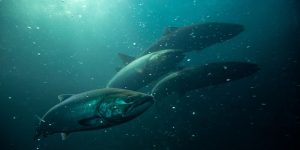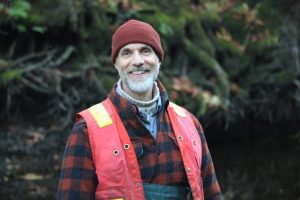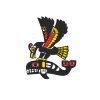Ashley van der Pouw Kraan
August 21, 2024

Chinook salmon. Photo by Dave Alan.
It was while hiking in Yoho National Park that Tom’s phone began to explode with messages.
He and his son had been enjoying the scenic trails, taking in the unique beauty of the landscape.
Puzzled, Tom, the Strategic Priorities Director at the Cowichan Watershed Board, pulled out his phone. A barrage of urgent notifications filled his screen, and the news was dire—thousands of fish were dying in the Cowichan River.
“And how ironic is that?” Tom mused during our interview. “Sitting on a glacier that’s melting and probably won’t be here when my son’s my age, looking at my phone blowing up because fish are dying in the Cowichan. It’s one of those moments I’m not going to forget.”

Tom Rutherford. Photo by Shalu Mehta of the Discourse.
Generations of Stewardship
The Cowichan has long been known for its prolific fish levels, and is particularly famous for its Chinook salmon. These large fish can grow up to 30 pounds, and have provided the Quw’utsun people with physical, cultural and spiritual sustenance for millennia. They are also crucial to the local environment. The Chinook salmon’s life cycle involves hatching in freshwater, maturing in the ocean, and returning to the river to spawn, thus contributing to the nutrient cycle that supports a diverse range of species in the Cowichan River and its surrounding habitats.
The Cowichan River also supports a variety of other fish species, including several species of trout, coho salmon and chum salmon. These species thrive in the river’s unique conditions, contributing to its rich biodiversity. The river’s diverse habitats—from the cool and shaded to the exposed and warm—provide ideal environments for the different life stages of these fish.
Monitoring efforts for the Cowichan River also have a long history. “The Cowichan River has been cared for by the Quw’utsun people since time immemorial,” Tom noted. “And we’ve seen profiles of the river in European papers dating over a hundred years back. John Wayne, Bing Crosby and Frank Sinatra all came to fish the Cowichan in the 1940s and 50s. All that attention left us with robust hydrological records and temperature records which, for a while, helped to inform river management decisions.”
Falling off the Knife’s Edge
Yet despite its historical significance, ecological importance and dedicated stewardship, the Cowichan River is no stranger to stress in recent years.
Freshwater inputs into the lake, which used to come like clockwork each summer, have dropped by almost a third in the last twenty years due to climate change. The steady flow of fresh water had supported a delicate balance, essential for the survival of numerous aquatic species, including the iconic salmon and trout. Lower water levels affect fish in multiple ways, disrupting the complex relationship between them and their habitat.
“Chinook salmon, for instance, are one of the charismatic mega-salmon species in our region,” Tom explained. “They’re essential to the Coast Salish people and their life cycle is intricately linked to the river’s flow. Adult Chinooks lay their eggs in gravel beds in October and November. These eggs hatch into alevins around Christmas, and by March, the fry swim up out of the gravel into the water column.”
During the first crucial months of their lives, these baby Chinook, weighing about half a gram, rely heavily on the river’s edges, where the vegetation provides them with shelter and food. “If the river is lower than usual during this period, the peripheral habitats along the riverbanks aren’t available,” Tom continued. “You might look at the river and think there’s plenty of water, but those edge habitats are vital for the Chinook juveniles. Without them, the fry can’t gain the necessary weight before moving downstream to the estuary.”
This initial growth period is critical for their survival. “They need to be about two and a half grams when they hit the estuary to have a reasonable chance of survival,” Tom said. “If they don’t reach that size, their ability to survive plummets.”
The negative effects of less freshwater coming into the Cowichan have been magnified by the simultaneous rise in water temperatures. As the summers grow hotter, the lake’s waters become warmer. Salmon and trout, species that thrive in cool, oxygen-rich environments, find themselves struggling to survive in these new conditions. Elevated temperatures not only stress the fish but also exacerbate the growth of harmful algae, which further degrades the habitat.
“Salmon and trout need specific habitats in the river, and what we’re seeing because of climate change is less water at different times of year and warmer temperatures,” Tom said. “These changes combine to alter the water chemistry and change the acidity of the water, creating additional stressors.”
“Last year, below the town of Lake Cowichan sewage outfall, we had a massive algae bloom,” Tom added. “The sewage plant hadn’t necessarily made any mistakes; they were just operating as they always had. But the combination of a high level of nutrients in the effluent, warm water temperatures, lower flows, and UV exposure from sunlight caused algae to grow rapidly and robustly.”
This rapid algae growth created a devastating cycle. “Algae give off oxygen during the day but consume it at night. When the algae die, they suck even more oxygen out of the water. This wild fluctuation in oxygen levels, combined with algae-driven changes in acidity levels altered the ratio of ammonium to ammonia in the water. Ammonium is generally safe for fish at moderate levels, while ammonia can cause respiratory issues, damage to gills and eventually death,” Tom explained. “It’s what killed the fish last summer.”
“For 20 years, we’ve been balancing on a knife’s edge,” Tom reflected. “Last year, we fell off the wrong side.”
The result was catastrophic. “We lost close to 100,000 steelhead trout juveniles,” Tom recounted. “There was probably 10 kilometres—maybe 20 percent of the river—where everything died. Totally unprecedented, with long-lasting effects. And I don’t have to tell you that it really got our attention, everyone’s attention.”
A Community United
The efforts taken to prevent another catastrophic fish die-off in the Cowichan River have been extensive and multifaceted, with various stakeholders working tirelessly to address the watershed’s challenges. “One of the great things about living here and doing the work that I do is that people have been working really hard to work together,” said Tom.
The community’s commitment to cooperation has roots going back to the 1990s, where, despite initial tensions, the efforts eventually solidified into collaborative and effective stewardship of the river. This was displayed in 2003 when the Cowichan Tribes partnered with the Department of Fisheries and Oceans to transport Chinook salmon up the river during a severe drought, marking the beginning of the Cowichan Stewardship Roundtable, which remains active today and was essential in the creation of the Cowichan Watershed Board.
In response to last year’s fish kill, this collaborative spirit has been crucial. Funded by the Pacific Salmon Foundation, Cowichan Tribes, the Cowichan Watershed Board, various government agencies and community knowledge holders have come together to develop comprehensive monitoring and response plans. “When this kill happened last year, people got together and decided that we need to do something about it ,” Tom explained. “We came up with two plans: a monitoring plan and a response plan.”
The monitoring plan involves continuous data collection from seven monitoring stations as well as twenty grab sample sites along the river. This data is crucial for early detection of issues and informed decision-making. “We have a bi-weekly call with all the folks involved in gathering the data, and we’ve started a series of Situation Room calls every Monday morning to look at the data and make decisions,” Tom said.
One significant change has been in the management of the wastewater treatment plant in Lake Cowichan. Short-term measures include the addition of alum to the outflow, which binds to nutrients suspended in the water, causing them to settle at the bottom of the lagoon and rendering them unavailable to algae in the river, preventing its prolific growth. The plant is also reducing or even halting the flow of effluent during periods of critically high temperatures. Long-term plans involve significant infrastructure upgrades, inspired by models that have already proven to be successful in similar situations.
Additionally, changes are being made to how the river water is being managed. “We’ve always tried to manage it in a way that would result in the most ecological benefit while acknowledging trade-offs if there’s just not enough water,” Tom explained. “This year, the focus is on maintaining higher base flows over the summer to support fish populations.”
Stress reduction measures have also been implemented, including angling restrictions to minimize human impact on the fish. “Certain areas of the river are closed which would have been open otherwise,” Tom noted.
The team is also working in partnership with the BC Conservation Foundation to identify and protect areas of the river that receive groundwater input and provide critical cold-water refuges for fish. “We’ve identified 14 of these sites and installed temperature loggers to gather data,” Tom said. “With this information, we’re working to increase protection for these areas through the implementation of a variety of regulatory tools available to local and senior governments – as well as education and support to assist private landowners steward these important habitats.”
A Murky Future
Despite these collaborative efforts, there is no guarantee that a repeat of last year’s tragic fish kill will not occur. “There is fear, right? There is anxiety,” Tom acknowledged. “Because we’ve done a lot, but it might not be enough.”
“I do think we’ve done a good job of doing everything we can,” Tom said. “This year is going to teach us a lot. But it may not be enough, and if it’s not, we’re going to have to come up with a better plan.”
Despite the challenges, Tom remains cautiously optimistic. “We’re way ahead of where we were last year. This year, things have worked out better. It’s not that it hasn’t been hot, but so far, we’ve avoided a major mortality event. And it was this time last year that everything went sideways.”
While the future remains uncertain, the work being done is a testament to the power of collaboration and the community’s deep commitment to preserving the Cowichan River’s ecosystem. Hopefully, this is just the beginning of a strong foundation that will prevent another fish kill and pave the way for the long-term sustainability of the river and its inhabitants.
See a dead fish in the Cowichan River? Let everyone know! Contact:
- The Federal Government at “Observe Record Report” (ORR): [email protected] / 1-800-465-4336
- The Provincial Government at the RAPP line: 1-877-952-RAPP
- Cowichan Watershed Board: [email protected]
 Email
Email



